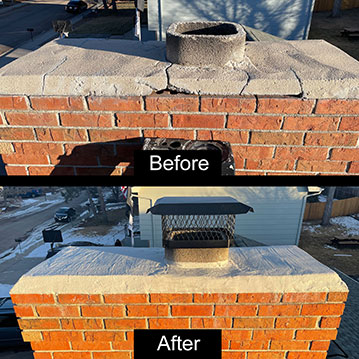Commercial Chimney Caps & Dampers: Control Your Exposure to Problems
What if you could see air and how it moved around individual units of an entire commercial property? What if you could watch as it moves in, through, and out of heating appliances including fireplaces, pellet burning stoves and those fueled by oil or gas?
You should be able to see air flowing smoothly in from the room to aid combustion. Then you’d see it travel up the chimney as exhaust fumes, without ever being pushed back into the living space of your tenants.
This ideal situation is not a dream but a necessary reality in the properties you own or manage. Without this flow of air inside and outside the building, health and safety problems begin to add up. That’s why Fresh Sweeps stands ready to help you improve indoor air quality, heating efficiency, and fire safety.
Fresh Sweeps Commercial Chimney Cap & Damper “Watch List”
- Watch Item #1: Room air fails to move into the fireplace or stove.
Flames have a hard time staying alive or achieving a meaningful height to produce adequate room and house heating comfort. Flame adjustment is difficult as the heating appliance frequently goes out and shuts down – at precisely the wrong times. - Watch Item #2: Noticeable air movement is felt in the room and house.
More like being outside than inside, the air moving can be felt as minor drafts to something almost like a breeze. - Watch Item #3: Air and fumes get pushed back into the room and dwelling.
This very real concern lands in the area of high risk to the health and safety of occupants. The system is failing to move air up and out and may even be releasing carbon monoxide or nitrogen dioxide in the home, apartment, or other rental unit.
If your properties are having any of these problems, call Fresh Sweeps to schedule an inspection today.
Commercial Chimney Dampers and Caps – What Are They and What Do They Do?
The chimney cap and damper both play critical parts in making the system work safely and efficiently. That’s because the proper movement of air, followed by post-combustion exhaust fumes, protects occupants from poor air quality. At the same time, the system must work properly to get the most out of every unit of fuel being burned.
Seated at the top of the building or rental home is what’s referred to as the chimney cap. Normally made of formed and shaped sheet metal, this item may have slits or screening to prevent debris, weather, and animals from traveling into the chimney flue that extends through the building’s exterior roof.
Such caps are found across all types of fireplaces, stoves and heaters as they complete the end of the combustion process. No matter whether the building and roof is brick, wood, asphalt, or metal, the cap affects the volume and speed of exhaust from the chimney system.
Fresh Sweeps technicians are skilled at repairing or replacing chimney caps, a job that’s too dangerous and technical for even skilled property managers. If a Level 1 or Level 2 Chimney Inspection has been conducted, their time on the roof may also include sweeping and other repair operations.
The damper in the heating and chimney system is another place where occupant comfort, health, and safety are determined; the damper also affects the fuel efficiency of the fireplace, pellet, gas or oil stove.
This device can be thought of as the “throat” of your heating system. It normally can be found right above the combustion chamber or at the very top of the chimney. When it is closed, it seals off the chimney, keeping cold air out. It only takes a relatively minor problem with this air regulating chimney component to create real concerns.
If broken or sticky, the damper can’t properly manage the air being pulled up and through the heating appliance. In the worse case scenario, it blocks airflow, sending smoke and poisonous fumes back into the room. Residents may or may not be aware of this problem until the damage is being done.
A trained Fresh Sweeps technician can spot damper problems quickly and efficiently. Because many of them are made of metal, corrosion occurring is likely a matter of time, but smooth operation doesn’t need to be hampered simply by rust. With the proper techniques, tools and parts, one or more dampers in a residential or commercial project are soon returned to safe operating order.
SAFETY ALERT: This Is a Job for Professionals Only
Given the difficulty, risk, and safety implications of chimney caps and chimney damper controls, property managers are advised to leave inspection and repairs to a trained Fresh Sweeps technician. Call us today to schedule a chimney inspection right away.








